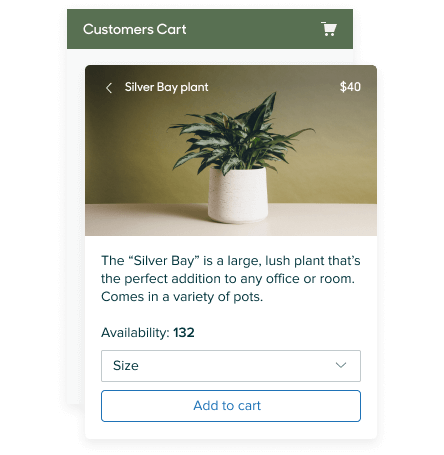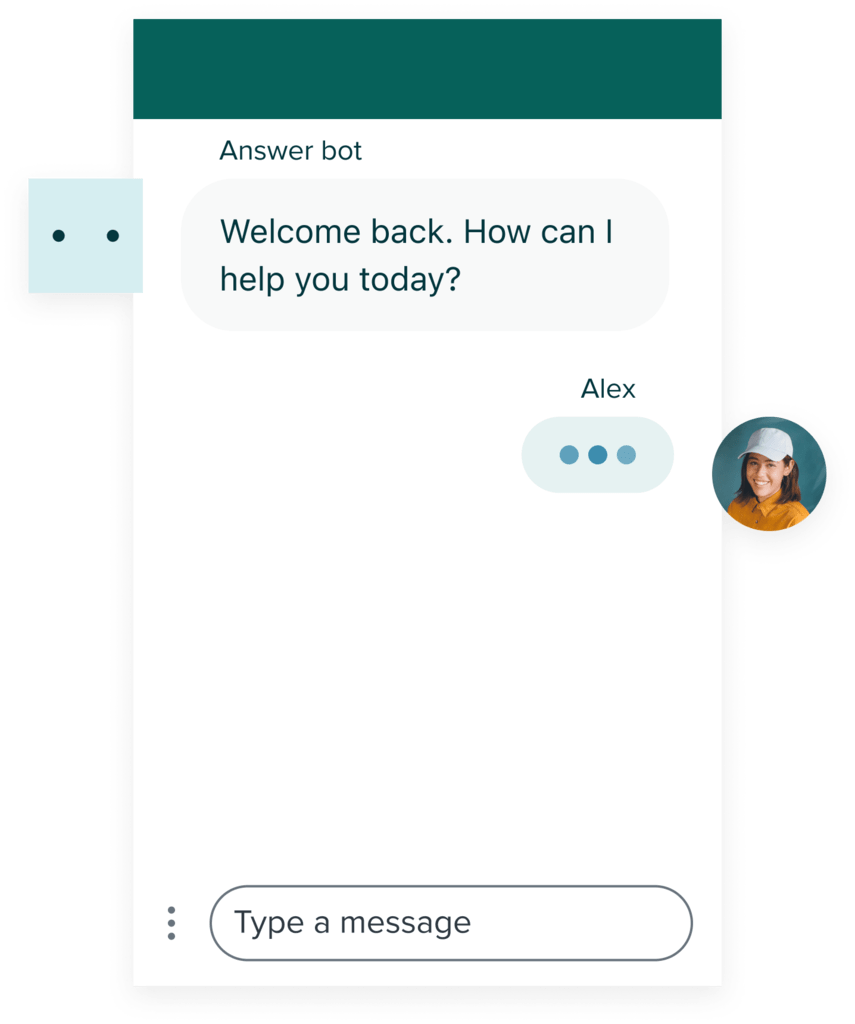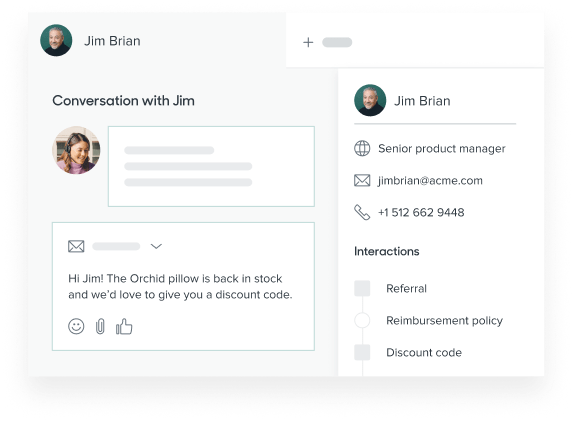Article • 19 min read
What is conversational commerce?
Conversational commerce isn’t just a trend – it’s a new way of connecting with customers.
By Jesse Martin , Staff writer
Last updated May 31, 2023
Quick facts about conversational commerce:
Conversational commerce is the intersection between e-commerce and messaging, where lines between brick-and-mortar retail and digital spaces blur.
Over 70% of people expect conversational experiences when interacting with brands and 62% think experiences should flow naturally between both physical and digital spaces.
Zendesk supports conversational commerce with web and mobile messaging, AI-powered bots and e-commerce integrations for seamless CX.
What is conversational commerce?
Conversational commerce has changed a lot over the last decade. In 2023, conversational commerce can refer to the numerous ways e-commerce and retailers use messaging and conversational technology, like AI and bots, to enhance and support the shopping experience.
Examples of conversational commerce in practice include:
Embedding a widget on an e-commerce page for shoppers to ask questions
Messaging-first marketplaces, where consumers sell directly to consumers
Using messaging apps to stay in touch with customers and share promotions
Grocery and delivery apps using in-app messaging between customers and shoppers
Integrating payments and user authentication when shopping in third-party messaging apps like WhatsApp or WeChat
Conversational commerce is almost everywhere – and now it’s up to brands to enable the conversational experiences customers have come to expect.

Just as the lines between brick-and-mortar retail and e-commerce experiences are blurred, so too are the ways messaging intersects with e-commerce, sales and support. The customer journey is complex and conversational technology creates new touchpoints for brands and customers all the time.
A brief timeline of conversational commerce
When Chris Messina, inventor of the hashtag (yes, really) coined the term in 2015, he remarked on recent innovations that suggested the world of e-commerce was on the brink of change.
Around the time Meta (back then, Facebook) acquired WhatsApp and voice assistants flooded our homes, Messina wrote, “these and related innovations suggest that ‘conversational commerce’ is growing and concierge-style services may become the primary way in which people transact on their mobile devices.”
Examples of conversational commerce in the early days include concierge shopping services on WhatsApp or the widely marketed use-case of live chat on e-commerce product pages to answer customer questions and upsell.
Futurists looked to China, where luxury brands built “mini-apps” inside of WeChat, creating fully integrated conversational e-commerce experiences inside messaging threads.
Today, conversational commerce is a fundamental part of e-commerce in general. According to CX Trends, 70% of customers expect conversational experiences when interacting with brands.
What are the benefits of conversational commerce?
Customer retention
Customers want interactions to feel authentic and personal: they want past interactions to inform future conversations, so that rather than being treated like a one-off ticket, they’re recognised for their patronage of your brand.

Messaging via web, mobile and social channels are the best avenue for these experiences, weaving each interaction into a larger dialogue between the customer and the brand.
The result is better CX, seamless conversations across channels and touchpoints, and a better bottom line for the retailer.
Upselling and cross-selling
By engaging your customer at the right time, enabling conversational commerce actually helps boost sales. A wisely placed web widget, proactive notification and even a great AI chatbot can all increase engagement by suggesting products and showing promotions.

The bot on this page, for example, can suggest a great report on how to improve your conversational support strategy – if we were a traditional retailer, we might clue you in on a discount code for first-time shoppers. If we were a smarter retailer, we could recommend a discount code based on previous exchanges.
Conversational customer data
Customer conversations are a goldmine of data. In fact, customer conversations can be used to create a language model to train and improve chatbots. They are also relevant sources of information that can be leveraged for product feedback.
Customers don’t want to be treated like strangers. Conversational data, when stored securely, can be used to authenticate customers and treat them to a more personalised experience. Rather than being treated like a stranger, they’re recognised and appreciated as the loyal customers they are.
Qualifying leads
Before your customer chats with a person, it’s likely they’re interacting with some sort of automation. In the past, this was probably a bit of a hurdle for small businesses to deploy, requiring special engineering, pricey bots and a higher headcount.

Today, out-of-the-box automation solutions are readily available in conversational commerce platforms. One of the key features of this sort of automation is that leads can be routed to the right person. Integrated forms in the chat can collect information to qualify the lead or authenticate the customer, ensuring they speak with exactly who they need to.
To learn more about how to build bots that support a conversational commerce system, check out this free guide with templates and examples.
Reducing abandoned baskets
Abandoned baskets are endemic for online retailers. Data shows that clever interventions – think conversational chatbots, proactive notifications or messages and a low first-response time – increase the likelihood of the customer completing their purchase.
Making messaging easily available to your customer is paramount. Not only does it reduce the friction needed to start a conversation with you but it also creates an opportunity for you to reach out and help them check out.
A conversational commerce best practice to help reduce abandoned baskets would be to make sure messaging is available on your e-commerce pages and to send a proactive message to keep your customer engaged.
What’s more, many social messaging apps and AI conversational commerce chatbots can actually complete purchases right in the conversation, without requiring the customer to leave the app or visit a different page.
How does conversational commerce work?
Conversational commerce refers to the numerous touchpoints along the customer journey where messaging, chat and conversational experiences influence the purchase decision.
Additional layers of functionality, like chatbots and automation, as well as integrations into e-commerce and payment platforms, mean that a singular conversational commerce experience is difficult to pin down.
But what does conversational commerce actually look like in practice?
Proactive chat on web or mobile pages
Click-to-message ads on web pages and social media
Using a third-party messaging app like WhatsApp or WeChat to communicate with a retailer, complete a purchase or make a payment
Conversational customer relationships that last
From sales to support, Zendesk helps companies deliver conversational customer relationships at any scale.
Common types of conversational commerce
Countless blog posts devoted to conversational commerce will suggest that it consists of:
Live chat
Messaging
Chatbots
Voice assistants
While these are all unique channels that foster conversational commerce experiences for shoppers, on the back end they are all the same. These are tools that are part of conversational commerce, not conversational commerce itself.
In reality, conversational commerce has a wider and more exciting scope.
Where does conversational commerce happen?
In messaging conversations on social, web and mobile
With a messaging widget embedded in an app or on a product page, a customer can message the brand to ask questions or seek help. Embedding messaging where your customers already are is a great way to reduce friction and encourage conversion. Like live chat, conversations can happen in real-time or be longer and ongoing.
On social messaging apps, like WhatsApp and Instagram, customers can strike up conversations with brands that have verified business profiles. Platforms like Instagram enable conversational commerce experiences right in the app, with new features being added to make it easier to shop, share and chat.
These can be automated with conversational commerce chatbots to deflect FAQs, route the conversation to the right salesperson and even carry out a fully automated purchase.At home or on the go with the help of voice assistants
Many people now connect their voice assistants to their accounts on shopping platforms like Amazon. Shoppers can ask Alexa to refill their shopping basket with toilet paper, with data from previous purchases informing their preferences. With a unified customer profile across all channels, conversational data from voice assistants, phone calls and messaging are all routed to the same place to provide the clearest insight into the customer.On live streaming and “social shopping” platforms
We’d be remiss not to mention social shopping and live streaming, where vendors large and small share their wares and interact with customers on camera. This is fertile ground for brands, who have to learn to manage the disconnected nature of livestream commenters, linking together products, purchases and shoppers.
According to some experts, “Instagram is becoming the new mall.” With Instagram’s live streaming features and shopping tabs, product discovery and instant query responses are easier than ever for brands.In click-to-message advertisements on social media and banner ads
Whether you’ve seen ads on Instagram Stories encouraging you to message them or a banner that opens a conversation in Messenger, click-to-message ads are one of the clearest instances of conversational commerce that demonstrates its veracity beyond the buzz.
Highly specific ad-targeting means customers who see these have a higher chance of engaging and converting. Plus, these conversations can be automated to easily carry out conversations at scale.On search engine results pages thanks to business profiles
Whether a business is found on a search results page or on a map, Google Business Messages enable customers to chat directly with the brands and businesses they’re searching for.
For customers who would much rather chat with a business than call, this is an increasingly popular way to get in touch. With simple automation, frequently asked questions can be answered in one touch and businesses (large and small!) can scale their support operations without adding to headcount.In places we’re only beginning to understand, like the metaverse
The metaverse is uncharted territory for customer relationships but that hasn’t stopped brands from trying to stake their claim in different digital arenas.
Conversational commerce experiences in the metaverse have a precedent – think of the way MMO games in the early 2000s, like Second Life or Habbo, paved the way for brands to monetise certain digital experiences. In today’s metaverse, the wall between digital experiences and real life is more porous, as people are more digitally connected across platforms and devices than ever before. Brands should tread carefully – without getting left behind.
4 examples of conversational commerce
Instacart
Conversations are built into the core of Instacart, where a complex orchestration of agents, shoppers and customers takes place almost entirely in messages. The customer can chat with the Instacart shopper to swap out products as part of their shopping experience. What’s more, by leveraging customer data and a conversational CRM, Instacart has “almost every piece of relevant data coming in on the ticket based on the user.” This means that agents don’t need to jump between channels and workspaces to get to the root of the issue.
Although Instacart is not a retailer, it enables third-party conversational commerce experiences between brick-and-mortar retailers and customers – a testament to the blurring lines of e-commerce and the real world.
Tile + Ada
Tile creates Bluetooth finders that attach to easy-to-lose items, like keys, wallets and pet collars. In partnership with Ada, a conversational intelligence platform, Tile provides seamless conversational support with the help of sophisticated AI chatbots.

According to senior customer support manager Justin Michaud, Tile was able to not only save costs on seasonal headcount but also generate revenue growth from customers who were being served at faster rates – all thanks to the conversational commerce-enabling chatbot.
The faster response time increases the likelihood of customers completing a purchase – and making another in the future.
Soho House
Personalisation is the norm in luxury. For private members-club Soho House and its subsidiary brand Mollie’s Motel, messaging is a way to provide luxurious, personalised experiences at scale.
The company relies on conversational CRM to bring together new touchpoints on its customers’ journey. Messaging only streamlines communication while surfacing opportunities to upsell and cross-sell. According to insiders, messaging typically drives a 30% increase in spending and overall higher customer satisfaction.
Four Seasons
If you’ve stayed at a Four Seasons property in the past few years, you may be familiar with the conversational concierge in the company’s app (and your other messaging apps).

Room service is only the beginning of the story. Four Seasons guests can carry out purchases, request upgrades and ask for bespoke recommendations – all inside of a continuous conversation. A leader in the guest messaging and digital concierge space, Four Seasons Chat is an award-winning, fully integrated conversational commerce experience that is now a widespread standard in luxury hospitality.
How three brands turned browsers into buyers with conversational experiences
To get started with conversational commerce for your business, check out our resources on messaging, building bots and integrations.
